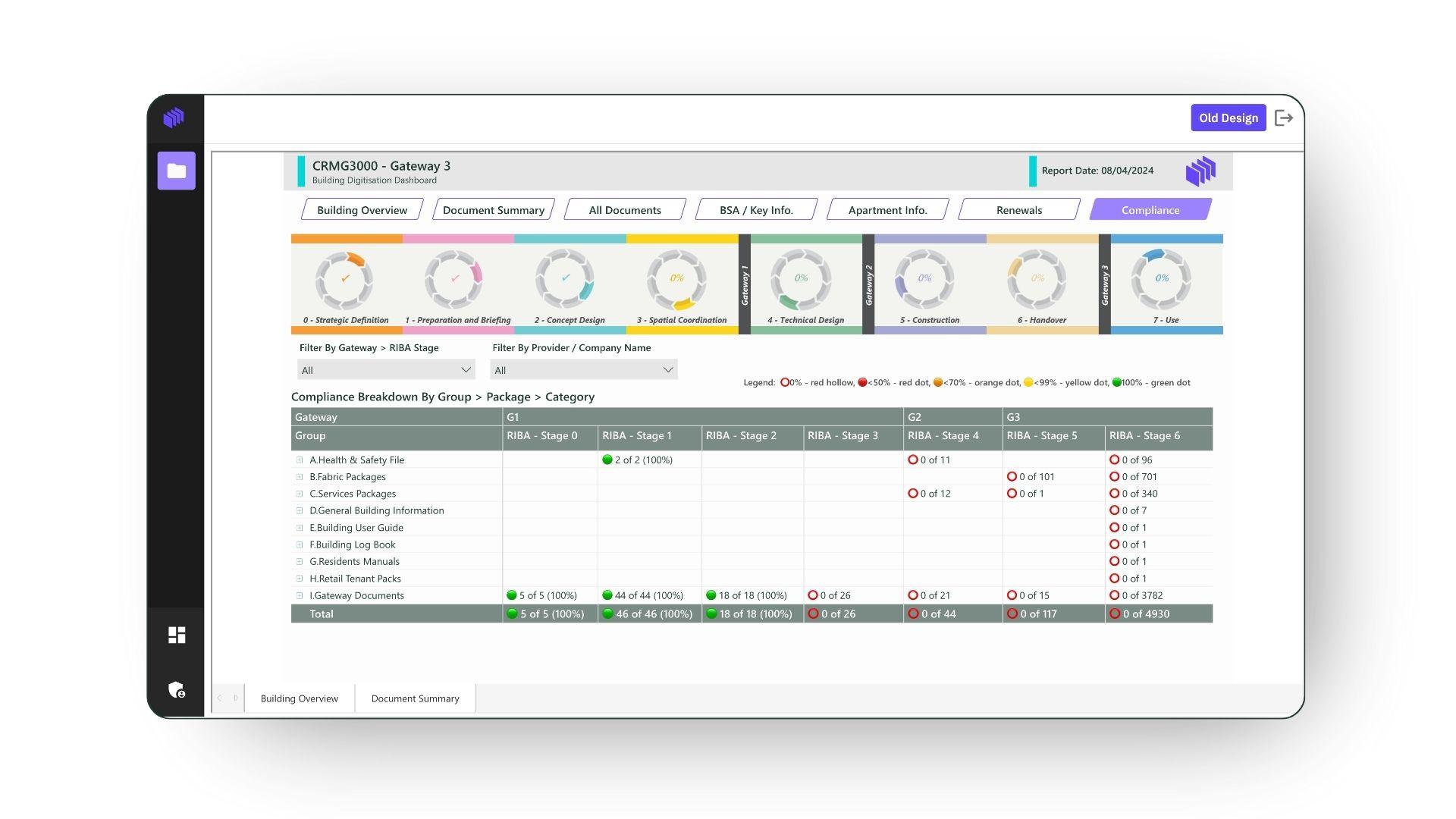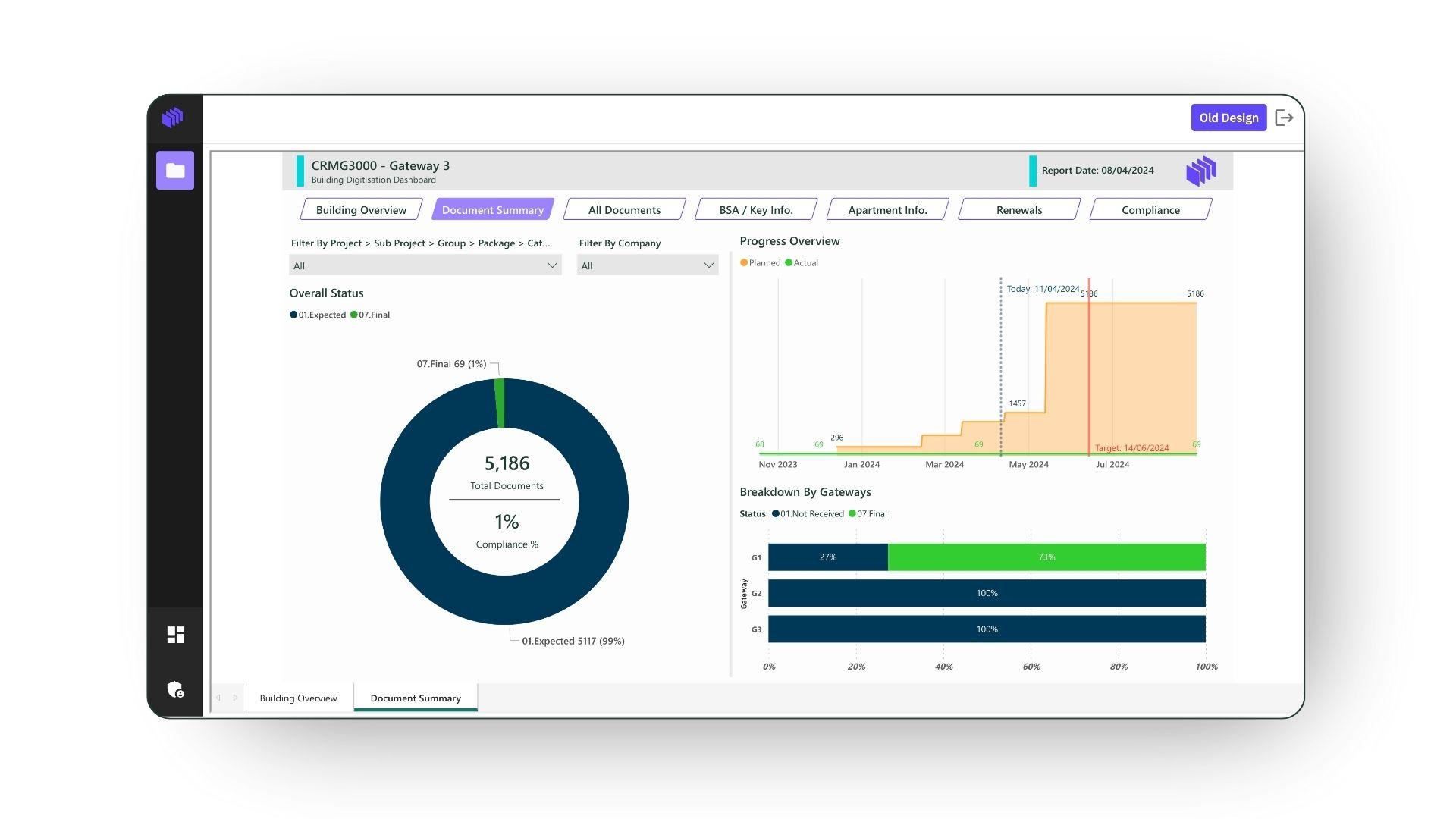The Key Building Information deadline
Deadlines passed to register higher-risk residential buildings (HRRB) with the Building Safety Regulator (BSR) at the beginning of October 2023. This means that it will be an offence to allow residents to occupy an unregistered building after this date. New buildings completed after 1 October 2023 now must be Gateway 3 compliant (new Building Safety Act decision point) have a relevant completion certificate and be registered before being occupied. All HRRBs also require key information about a building’s structure and fire safety to be submitted to the BSR within 28 days of registration.
For background reading on Key Building Information requirements, read our blog, ‘Navigating Key Building Information: Countdown to Compliance’.
What do the Key Building Information deadline and Gateway 3 mean for contractors?
This new BSR deadline has wide-reaching implications and, for contractors, it’s important to keep a robust record of building information and be able to evidence compliance. From October 2023, contractors will have to verify and demonstrate that all construction has been completed according to the as-built design, as well as required standards and regulations in line with new gateway stop/go points, which have been brought into effect as part of the Building Safety Act. If they can’t demonstrate compliance, they won’t be able to secure a Completion Certificate at Gateway 3. Without this, asset owners won’t be able to start moving residents into a higher-risk building. It also means, the information may not be available and present to build a safety case, which is another requirement of the Building Safety Act from April 2024.
This new deadline marks another step towards realising the new BSR building safety framework. Those who aren’t ready will have to get their house in order soon to avoid delayed project completion. So, what are the next steps for those looking to get compliant fast?
Simplify Gateway 3 applications
Discover how the #1 solution in Digital Handover can help you secure Completion Certificates more quickly.
Next steps for contractors
Step 1: Digital Competency
New regulations for Higher-Risk Residential Buildings mean that dutyholders are required to exhibit certain competencies and appropriate behaviours. The principal contractor must plan, manage and monitor building work so that it complies with relevant building regulations, including the flow of information to make sure it’s readily available to those who need it. This involves integrating technology into operations and developing dedicated digital systems for the management of key building information. The onus is on contractors to retain accurate and reliable documented information, harness data effectively to make better decisions, and ensure compliance can be evidenced in line with relevant regulations. Here are some key things to consider:
Expert Support: Engaging a dedicated team of specialists in data management, information collation, and technology implementation can provide the guidance needed to kick-start your journey toward digital competency and compliance.
Data Gathering and Structuring: Gathering the relevant information can be a challenge when data and documents come from various sources and in multiple formats, including external partners or sub-contractors, internal databases, and on paper, PDF or Excel. This data should be processed, categorised, and structured in line with regulations, and doing it yourself can be hard. Working with a specialist can take this pain away, so you can focus on the work you do best — the build.
A Single Data Platform: Centralisation is key to efficient data management. Bringing all your data and documents into a single, unified platform is crucial when you must maintain a clear record of the work performed on a project or within a building and evidence that it meets compliance ahead of completion. With a single platform, you can manage data more clearly and also see the information gaps.
Understanding Data: Beyond merely collecting and storing data, it’s vital to understand what your information means. When you have your information in place that is structured and categorised you can extract valuable insights from it, drive smarter decision-making and adapt to changing circumstances more effectively. Understanding data also delivers productivity enhancements.
Step 2: Golden Thread of Information
Step 2 in the journey towards compliance is all about establishing the Golden Thread of Information. It’s about having data accessible in one place able to integrate with different systems and creating dedicated dashboards, workflows, and data management processes to ensure that information flows seamlessly and continuously throughout a project’s lifecycle. By prioritising data accuracy, accessibility, timeliness, collaboration, and compliance, organisations can unlock the full potential of the Golden Thread, enhancing project efficiency, transparency, and success. To do this you’ll need:
Dedicated Dashboards: A real-time view of the project’s progress and status, with actionable information that can be analysed and reviewed to understand information gaps and document and compliance status.
Golden Thread Process: The Golden Thread is not a static concept. It evolves alongside the project or building it supports and is the product of good information management. Organisations must commit to setting up processes and workflows to ensure data and documentation are consistently and accurately captured, updated, and shared as the project evolves.
Data Accuracy, Accessibility, Timeliness and Auditability: Information must be reliable and up to date and be accessible to the right people at the right time, including project managers, engineers, architects, the regulator and most importantly residents when a building is occupied. Maintaining a clear and traceable history of data and documentation simplifies compliance audits and regulatory reporting.
Data Integration: Information within the golden thread will inevitably need to be useful across different systems to meet the needs of different stakeholders. Aligning information to industry standards and schemas provides the first step to connecting information, creating a consistent digital language through all information management activities across the life of an asset.

Step 3: Gateway 3 application
Gateway 3 is a critical milestone for the construction of Higher-Risk Residential Buildings. It represents a stop/go point where detailed plans and documentation are reviewed to ensure that the as-built structure complies with the as-built design and all relevant regulations and standards. This step is crucial for obtaining Completion Certificates. To get past go consider the following:
Robust Record-Keeping Requirements: As building projects progress, there is a substantial amount of documentation generated. Robust record-keeping requirements ensure that nothing is overlooked, and all necessary documentation is readily available when needed.
Dedicated Gateway 3 Template: A dedicated Gateway 3 template is structured and specifically designed to capture the essential information and documentation required for this stage. This template serves as a standardised checklist to ensure that all relevant aspects of the building project are addressed and reduces the risk of missing critical information.
Progress and Compliance Tracking Dashboard: A dashboard dedicated to tracking progress and compliance is a valuable tool during the Gateway 3 application. It provides a visual representation of how various aspects of the project are progressing, what information has been fulfilled, and whether they meet compliance requirements.
Simplifying Completion Certificate Acquisition: By meticulously documenting information ready for compliance and using a Gateway 3 template and tracking dashboard, organisations can streamline the process of securing Completion Certificates. This, in turn, expedites the transition to occupancy and operational phases.
To learn more about Gateway 3, read our blog, ‘Gateway 3 of the Building Safety Act Explained’.

Step 4: Building Safety Case
Building the Building Safety Case is a pivotal exercise for ensuring the long-term safety, compliance, and risk mitigation for a building. It will also be mandatory from April 2024, and involves the careful collection and organisation of critical documents and information related to building safety, structural integrity, and operational functionality and should be able to deliver the below:
Gathering Building Safety Risk Documents: The Building Safety Case begins by gathering a comprehensive set of documents that help to adequately undertake safety risk assessments. This information includes basic building information, construction details, materials, services, utilities, and certificates. It’s important that all safety-related information is systematically compiled and readily accessible. Having a central repository makes housing essential building information more straightforward for contractors, building owners, facility managers, and regulatory authorities alike.
Certificates and Compliance Records: Certificates play a significant role in the Building Safety Case. These certificates may include compliance certificates, building code certifications, fire safety certifications, and material compliance documentation. Demonstrating that the building adheres to applicable codes and regulations is vital for ongoing safety and compliance.
Safety Risk Assessment: A critical aspect of the Building Safety Case is the safety risk assessment. This involves identifying potential safety risks, evaluating their impact, and implementing measures to mitigate or manage these risks. The case should provide a clear overview of identified risks, associated documentation, and the strategies in place to ensure safety.
The digital handover process represents the crucial final step in a construction or building project. It involves transferring all relevant project data, documentation, and information, which is now part of the Gateway 3 compliance process, to the client, who will assume responsibility for the ongoing maintenance and operation of the building. This phase is critical for ensuring client satisfaction, reducing the burden on aftercare teams, and mitigating the risk of non-compliance. This data is also required to support the creation of a building safety case.
Reducing On-Site Workload: Construction projects are often hectic, with on-site teams managing multiple tasks simultaneously. Streamlining data collection using a dedicated team working with proven templated structure and digital tools takes the pain away from on-site teams. By optimising the data collection process and eliminating the need for last-minute data gathering, on-site teams can focus more on core construction activities.
Improved Handover to Clients: Clients expect a smooth transition when they take possession of a building and it’s even more important now that they have additional responsibilities under the Building Safety Act. A digital handover process that is aligned with regulatory responsibilities ensures that all relevant documentation, including as-built plans, manuals, warranties, and compliance certificates, is readily available and well-organised. This enhances the handover experience, making it easier for clients to assume responsibility for the building and for the regulator to sign off.
Reducing Aftercare Burden: By providing Aftercare teams with a comprehensive digital handover package, the burden is significantly reduced. They have access to all the information they need to carry out their responsibilities effectively, minimising downtime and disruptions.
Mitigating Non-Compliance Risk: Failing to provide clients with complete and accurate documentation can result in non-compliance issues down the road. A digital handover ensures that all necessary compliance documentation is transferred to the client, reducing the risk of regulatory violations.
Why can’t I use my CDE?
While many contractors may already have a CDE today to manage project data, they may not be well equipped to manage the Gateway 3 process or be able to gather a consolidated data set for a comprehensive building safety case.
CDEs are great for managing project information, but they are not necessarily tailored to meet the changing legislative requirements outlined in the Building Safety Act. Where contractor CDEs may be familiar to stakeholders across the building supply chain, they don’t include templates, forms and workflows designed specifically for Gateway 3, Safety Case and golden thread compliance. Without a mechanism to be able to identify and fill data gaps in accordance with regulations, it will be difficult for contractors to demonstrate compliance.
At the same time, the client or asset owner will not have access to contractor platforms post-project completion and just providing multiple exports to be transferred to the client will no longer be sufficient for them to evidence and manage ongoing compliance if documentation is not organised in accordance with regulations.
To find out more and take full control of Key Building Information, get in touch with our expert team to arrange a consultation and demo.